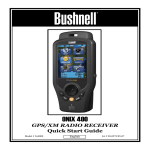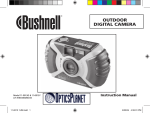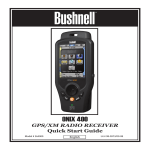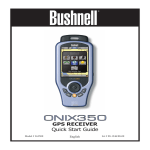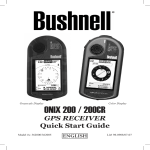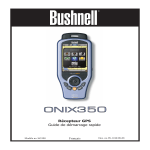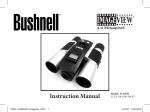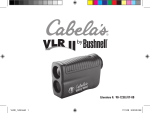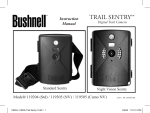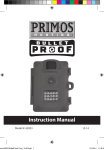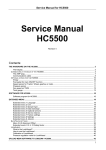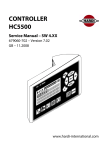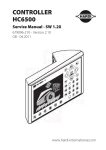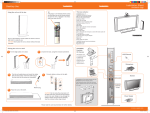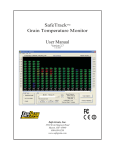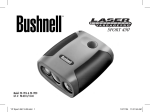Download Bushnell ONIX 400 364000 User's Manual
Transcript
ONIX 400 GPS/XM RADIO RECEIVER Quick Start Guide Model # 364000 ONIX400 1LIM QS Guide-Feb08 Revi1 1 English Lit # 98-0973/02-08 2/20/08 8:55:53 PM notes ONIX400 1LIM QS Guide-Feb08 Revi2 2 2/20/08 8:55:53 PM Warnings and Notices GPS System & Map Data Accuracy Notice: The Global Positioning System (GPS) is operated by the government of the United States, which is solely responsible for its accuracy and maintenance. The system is subject to changes which could affect the accuracy and performance of all GPS equipment. All map data sources contain some level of inaccuracies or incomplete data. Bushnell strives to provide the most recent map information at a reasonable cost. Basemap data is supplied by NAVTEQ® , a major supplier of digital map data for handheld and vehicle navigation products worldwide. NAVTEQ® continually refines and improves their digital map databases to maintain their leadership position in the industry. Warning: This device is intended as a supplemental handheld navigation aide only. The user assumes all responsibility associated with the use of this product. It must not be used for any purpose requiring precise measurement of location, direction, distance, velocity or topography. This device should not be used for any aircraft navigation applications. Warning: This device uses a rechargeable lithium-ion battery pack. Follow the directions for charging the battery before use. Do not attempt to open the battery pack, modify or charge it other than as directed. Check the battery compartment after the unit has had any prolonged exposure to significant amounts of water (rain, snow, etc), and remove any moisture before continuing to use the unit. If it becomes necessary to dispose of the battery pack, please take it to your local waste collection service or recycling center for environmentally responsible processing. Vehicular Use Notice: Bushnell is committed to the safe and responsible enjoyment of the outdoors. Do not use this product while driving. An accident can result in property damage, injury or death if the operator fails to practice prudent driving practices. It is the sole responsibility of the driver of any vehicle to operate the motor vehicle in a safe manner. Information from the GPS unit can distract the operator of a motor vehicle. It is unsafe to operate the controls of the GPS unit while operating a motor vehicle. If used in a motor vehicle, it must not be used by the operator of the motor vehicle. If it is used in a motor vehicle it must be mounted in a manner such that it does not distract the operator, does not interfere with the operator’s field of view, and does not block or interfere with the air bags or other safety mechanisms of the motor vehicle. Software License Agreement BY USING THE ONIX, YOU AGREE TO BE BOUND BY THE TERMS AND CONDITIONS OF THE FOLLOWING SOFTWARE LICENSE AGREEMENT. PLEASE READ THIS AGREEMENT CAREFULLY. Bushnell grants you a limited license to use the software embedded in this device (the “Software”) in binary executable form in the normal operation of the product. Title, ownership rights and intellectual property rights in and to the Software remain with Bushnell. You acknowledge that the Software is the property of Bushnell and is protected under the United States of America copyright laws and international copyright treaties. You further acknowledge that the structure, organization and code of the Software are valuable trade secrets of Bushnell and that the Software in source code form remains a valuable trade secret of Bushnell. You agree not to decompile, disassemble, modify, reverse assemble, reverse engineer or reduce to human readable form the Software or any part thereof or create any derivative works based on the Software. You agree not to export or re-export the Software to any country in violation of the export control laws of the United States of America. ONIX400 1LIM QS Guide-Feb08 Revi3 3 2/20/08 8:55:54 PM Thank you for purchasing the Bushnell ONIX400 – the most advanced outdoor navigation device available today! This device is capable of receiving both GPS Satellite and XM Satellite Radio signals in an outdoor environment. The ONIX400 comes preloaded with a base road map of the United States and Canada including a Points of Interest data base. The GPS receiver has the capability to receive satellite signals worldwide. The XM Satellite Radio receiver presently only functions in the United States and Canada. ONIX has been designed to be much simpler to operate than other handheld GPS receivers, while offering powerful features like TruView navigation, which allows you to layer satellite photos or topographic maps right over your trail map screen, providing a useful “real world” frame of reference1. And for the first time in a handheld GPS device, the ONIX400 lets you receive and view XM Weather data for your location right on the map-you can even layer weather radar over a satellite photo of the area! And, you can listen to XM Radio music or news and keep an eye on the latest sports scores or weather developments without leaving the GPS map screen2 ! As much or as little information as you choose can all be displayed together in various combinations on the extra large 3.5” full color LCD screen. Easily create and store user profiles that let you store your most frequently used personal setups, including satellite photos of your favorite camping or hunting area. Bushnell’s exclusive SafeTrack™ battery conservation feature extends your battery life while maintaining GPS contact, so you can check your current location anytime without the restart delay typical of other GPS receivers. You will find your ONIX to be an invaluable companion for all your outdoor adventures. Just hit the “Hot” button to quickly see your current position, or view updated nearby weather conditions. Before using your new ONIX, please read the instructions contained in this manual and take time to familiarize yourself with the unit’s operation and many great features. You may want to start near your home, by turning on the ONIX, then pressing the MENU button to run through the six basic screens (MAP, NAV, XM Weather, XM Radio, SAT, SET) while reading the manual section for each. After that, practice using the “Hot” button and 5-way button to see and select from a menu of options, perhaps on the SET screen by setting a few personal preferences for information displays. Once you begin feeling more comfortable with the controls and screens, the best way to really learn to use your ONIX is to take it outside (right in your own neighborhood or a local park), and let it lock onto the GPS satellite signals as you watch the SAT page (be patient, this can take 3 or 4 minutes the first time you use it-make sure you have a clear view of the sky and are not right next to a large building for best results), then take a short walk and finish by using the ONIX to guide you back to your starting point (you can either mark a waypoint at the start by clicking the center of the 5-way button twice, or just begin walking, later following the dotted “breadcrumb” trail back). After that, you might try downloading a satellite photo of this local area, layer it on top of the map screen, and try walking the same trail again, setting a few waypoints as you go. Continue referring to this manual and practicing as often as necessary until you master the basics, before heading out on a hike of any significant length or attempting to navigate an unfamiliar area. ONIX 400 Model #36-4000 FEATURES • Extra Large 3.5” Full Color LCD • WAAS Enabled • Heads-Up Digital Compass • Built-In Base Maps (North America) • Save/Load Waypoints, Trails and Routes • Stores Up to 1000 Waypoints & 20 Routes • Micro SD Card Storage (128MB card inc.) • Exclusive Screen Layering inc. XM Weather with Bushnell ONIX Channel Monitor ONIX400 1LIM QS Guide-Feb08 Revi4 4 • Download Topographic Maps 1 • Download Georeferenced Satellite Photographs 1 • Built-In SiRF Technology 20 Channel Receiver • Waterproof (IPX7 Standard) • Durable Rubber Armoring • SafeTrack™ Battery Conservation Mode • Display XM WX Weather Data 2 • Listen to XM Radio Entertainment and Sports 2 1 Download satellite photos and topo maps at www.bushnellgps.com 2 Subscription to XM weather and/or entertainment services required 2/20/08 8:55:54 PM included Parts List • ONIX 400 GPS/XM Receiver • Lithium Ion Battery Pack • 128MB MicroSD Card • AC Charging Cord • USB Cable • Earbuds • Info Pack with Quick Start Guide, Registration Card, and CD-ROM battery charging, cleaning & maintenance • The internal Lithium Ion battery pack must be charged before the ONIX can be used for the first time. Make sure the MicroSD card is inserted in the card slot first, then attach the battery pack by lining it up with the opening on the bottom of the unit, pushing it straight onto the unit until flush with the surface, then sliding the battery down towards the end with the USB and accessory ports, until it locks securely into place (to remove the battery, press the soft release area (see yellow arrow below) at the curved end of the battery, then slide it up and lift directly away from the ONIX body). Connect the supplied AC charging cord to the accessory connector port at the bottom of the unit, then into a wall outlet. When the Status LED changes from red to green, the battery is fully charged. • The ONIX is designed to be waterproof to a depth of 1 meter (IPX7 rating), however it is recommended that the user opens and checks the battery compartment following any submersion or prolonged exposure to rain, snow, etc. Any moisture observed inside the battery compartment or on the exterior of the battery pack or MicroSD card should be dried off immediately and completely. Prolonged submersion (over 30 minutes) and/or to water depths greater than 1 meter can cause damage to the unit. • If the ONIX exterior becomes dirty, clean it with a soft cloth dampened with a mild detergent solution, then wipe dry. To avoid possible scratches, a (dry) micro fiber cloth is ideal for cleaning the display screen. Do not use chemical solvents or cleaners of any type on the ONIX unit’s exterior, battery compartment, or display, as these may damage plastic components. MicroSD Card Push here to release battery pack To attach battery pack Battery Pack & Compartment Details ONIX400 1LIM QS Guide-Feb08 Revi5 5 Push In to Insert or Remove Battery pack attachment lugs 2/20/08 8:55:55 PM controls and ports identification Helical Satellite Antennas and Lanyard Attachment Current Page Indicator 3.5” Color LCD Display Screen 5-Way Button Pad: Used to navigate on screen, select from menu options, and create waypoints. Press Up/Down arrows to select items in a menu, Right arrow to view submenus (if available), Left arrow to exit the menu. Press the “OK” center button to confirm a menu selection or turn an option on or off. Press the center “OK” button to set a waypoint on the MAP. Battery Level Indicator Power Button: located on right side of ONIX. Push to turn on. Once the unit is on, press briefly to see the Power Menu. Hold button for 2 sec to turn power off. Zoom Buttons: Zoom the view closer in or further out on maps and photos by pressing the “+” or “-” buttons. Also used as volume controls for XM Radio. EXIT Button: Press to exit any menu and return to current screen with selected layers and info boxes. USB Port: connect to PC with supplied cable MENU Button: Press to view Main Menu with choice of 6 Pages. (Hold down to see Display Options for layers/ info boxes.) “Hot” Button: controls all actions: • Navigation • SafeTrack • XM Weather-Location Selection • XM Radio Preferences Status LED: Red=charging, Green=battery charging complete. Blinking Red (during use)= SafeTrack mode Accessory Port: used for AC charging cord and optional XM accessories ONIX400 1LIM QS Guide-Feb08 Revi6 6 Battery Pack Module: houses Lith-Ion battery pack. Also covers MicroSD card slot. Audio Out Jack: connect supplied earbuds to hear XM Satellite Radio entertainment 2/20/08 8:55:56 PM The six pages OF THE ONIX400 1. MAP-you will likely spend the most time on the MAP page, since it shows your current location relative to other objects and places. You can layer aerial photos, weather information, a compass and other navigation related items alone or in combinations over the top of the base map, making it even more useful and informative. 2. NAV (Navigation)- a basic display of the digital compass. View your current heading and true or magnetic north at any time by switching to this page. 3. XM Weather-use this page to choose the day/time and location for weather forecast data (see included “How to Activate XM Service”). Note: XM reception must be set to “ON” in the SET Page. 4. XM Radio-select from over 170 channels of music, news, sports and entertainment (XM reception must be activated) . Listen to your favorites while you navigate, or just listen at the end of the day when you reach your campsite, boat, or home. Note: XM reception must be set to “ON” in the SET Page. 5. SAT (Satellite)-this page allows you to monitor the signal strength of multiple GPS satellites, confirming when you have a “lock”-adequate number and quality of satellites to ensure good reception. 6. SET (Setup)-go here to set your personal user preferences, enable XM satellite reception, setup a custom user profile, and other user adjustable operating utilities. 1. MAP Page 2. NAV Page 4. XM Radio Page 5. SAT Page 3. XM Weather Page Main MENU 6. SET Page Press the MENU button briefly, use the 5-way buttons to select (highlight) a page on the menu display, then press OK (center button) to view and use that page. ONIX400 1LIM QS Guide-Feb08 Revi7 7 2/20/08 8:55:57 PM TIPS FOR MAXIMIZING BATTERY LIFE IN THE ONIX 400 The ONIX400 uses the latest technology and exclusive features to provide the most efficient combination of battery life and functionality. The rechargeable Lithium Ion battery pack provides an extended capacity of power to run both your GPS and XM Satellite Radio features simultaneously. Power Saving Options The following features allow the user to extend battery life. 1)Power Menu a. Access this quick menu anytime by clicking the Power Button (see Figure 1) Options to increase battery life: • Backlight – Turn the backlight “Off ” when outdoors in daylight to increase battery life. Use the backlight in low light, or dark conditions, or when indoors. • Brightness – Increasing brightness increases power consumption. Select a brightness level based on your viewing requirements • XM/Sports/Weather – See Figure 2. 1. XM must be turned “On” to listen to XM Radio audio programming. 2. When not listening to XM audio programming, turn XM “Off” to significantly increase battery life. 3. The “Auto Update” mode provides for periodic updates of XM Weather and XM Sports data while providing extended battery life versus the XM “On” mode. XM audio programming is not available in this mode. • GPS – Turn GPS “Off” when not using the GPS navigation functions or when indoors where GPS signals are not accessible. Figure 1 2)SafeTrack™ Battery Conservation Mode Figure 2 a. SafeTrack Mode creates a low power state while maintaining satellite connection b. Utilize SafeTrack to extend battery life during navigation c. XM Satellite Radio audio does not function when Safetrack is activated d. XM Weather and XM Sports information can be updated while utilizing SafeTrack (See “Auto Update”) e. Access SafeTrack from the Hot “H” button menu (see Figure 3). For more information on Safe Track please reference “Using the SafeTrack Battery Conservation Mode” on pg.18. Figure 3 Utilize SafeTrack™ and Auto Update modes to maximize battery life. ONIX400 1LIM QS Guide-Feb08 Revi8 8 2/20/08 8:55:59 PM getting started 1. You must charge the battery pack before using the ONIX400. Attach the battery pack (first, verify that the MicroSD card is installed in its slot), referring to the instructions and photos on pg. 4. Plug the AC charger cord into the accessory port (pg. 5), then into an AC outlet (110-120 volt/60 cycle). 2. The initial charge may take up to 4 hours. A full charge is indicated when the status LED below the orange Hot button changes from red to green. You may then disconnect the charger cord from the outlet and accessory port. Store it safely for future use. 3. To ensure adequate satellite signal strength, make sure you are in a location with an unobstructed view of the sky (GPS units typically do not work well indoors unless you are very near to a window) 4. Press and hold the power button for a few seconds until the display starts up. 5. Press the MENU button briefly. You will see the Main Menu screen, with six “pages” to choose from. Use the 5-way switch to select (highlight) SAT, then press the “OK” (center) button. 6. You are now viewing the Satellite (SAT) page. You will begin to see multiple icons on the circular “radar” screen, representing the closest satellites to you in the global GPS system. These icons will turn green as the ONIX “locks on” to each satellite, and the satellite ID# will be shown. The bar graph below the “radar” screen indicates the relative signal strength of each satellite. Once you have a lock on at least 3 or 4 satellites, you are ready to navigate. Note that the satellite “lock” process will take longer (up to 3 or 4 minutes), the first time you use your GPS in a new geographical area, but will be much faster on future usage in the same area (see “Reset Data” in the SET Page>GPS options, if you later relocate more than 300 miles away from your initial area). You can check reception with the SAT page at any time, but will likely find that you use it less than any other page-in fact, you may simply go directly to the MAP (or any other) page the next time you use your ONIX. 7. You’re ready to go! Let’s take a look in more detail at the other pages, then see how easy it is to enjoy the many features and capabilities of the ONIX400 for yourself to mark and name your own waypoints (locations or objects you want to return to later), navigate towards a nearby point of interest, layer a compass or weather radar over the map, and even listen to a ball game or your favorite music while you walk! To use the XM Satellite Weather and/or Entertainment features of the ONIX400, you will first need to set up your subscription to these XM services and activate XM reception for your unit. It’s fast and easy... just follow the directions on the “XM Satellite Service Activation” page included in your ONIX information pack, or call 1-800-985-9200. In order to activate the XM Radio services, you will need your XM Radio ID number. This ID# can be found on the product label inside the battery pack compartment, or on the SET page in the “Unit Info” (Go to the SET page, press UP or DOWN buttons to highlight “Unit Info”, then press the OK button to display all unit info, including your XM ID number). ONIX400 1LIM QS Guide-Feb08 Revi9 9 2/20/08 8:55:59 PM exploring the pages : Options And Settings Press MENU, then use the 5-way button to select (highlight) a page, then press “OK” (center button) to view that page. The current page you are on is always indicated in the box at the top of the display, just below the “Bushnell” logo. The MAP page is the most commonly used, and has the greatest number of display options that can be layered over the basic map elements. 1. The MAP Page Fig 1. MAP Page Base Map Fig 2. MAP Page Cursors Fig 3. MAP Page 10 Layer Options ONIX400 1LIM QS Guide-Feb08 Revi10 10 You will primarily refer to the MAP page while navigating with the ONIX400. Using Bushnell’s exclusive screen layering, this page can display multiple location and navigation related information in a single view. The following items are always displayed on this page: • Base Map (Fig. 1)-primary streets and location, similar to a basic road map. • Cursor-shows your location and direction. The cursor can assume one of three shapes (Fig. 2): -a crosshairs cursor that allows you to pan the map, check the position of waypoints or POI when moved over them, use as a distance measuring tool, or create routes. -a bearing arrow that shows your navigation direction when you are moving (or heading when you are not actively navigating) -a circle-“you are here locator” to display your current location relative to the map •Zoom Display Level-on lower left next to the Info Boxes. Shows scale or actual distance represented by height of current display (e.g. “10.2km” span from top to bottom of screen). Use the “+” and “-” buttons to change the zoom level. MAP Page Layering Options You may choose to add other items to your view of the MAP page. To select these items, hold down the MENU button for 2 seconds, then press the UP button-you will see a map page layer options screen (Fig. 3). Use the 5-way button to move up and down the options, press the center button to select (check) or deselect (uncheck) the items you wish to include in your view. The MAP page layer options list: •Weather-display a variety of weather info, including weather radar. Press the Right button to see a list of these weather info options, use the Up/Down buttons to select, then “checkmark” any items you wish to view layered on the map screen by pressing the OK button. 2/20/08 8:55:59 PM exploring the pages : Options And Settings Note: Your XM Weather subscription must be activated, and XM reception turned on, before it is possible to display any weather information. These are the Weather Info options (Fig. 4): a) Animate (view weather history in motion) b) Quick Radar (lower detail precipitation map, updated every 2 minutes) c) Radar Summary (data series updated every 15 min. Note that “animation” of the radar summary screen requires ≥30 min. of uninterrupted data reception) d) Clouds e) Rain/Snow Advisory f) Wind Advisory g) Road Conditions h) Visibility i) County Warnings (within borders of your current county) j) All Warnings (and advisories. Not limited to current area) k) Lightning Note: not all weather data can be displayed simultaneously •Compass-indicates your current direction. •Range Rings (Fig. 5)-visual tool that represents distance on your map or photo within a circle. The distance shown is the radius of the circle. This radius is half the zoom level. Use Up/Down on the 5-way pad to adjust the radius of the rings, then press OK to exit. • Photos (Aerial/Satellite) (Fig. 6) -superimposed over Base Map if desired. You do not need to manually select the right photo (or topo map) to use, as these downloaded files are “geo referenced”, enabling your ONIX to choose the correct photo automatically, based on your current location and zoom level. Note that while both types of images can be stored at the same time on your ONIX, only one of them (photo or topo map) can be displayed over the base map at a time. •Topo-the topographic map you choose from files you download and store in the ONIX will be layered over the base map •North UP-when checked, the top of the screen is oriented due north. If unchecked, the top of the screen is oriented to your current direction of travel (i.e.“track up”-like automotive GPS units). Satellite photos and topo maps are displayed “North Up” by default. • Map Data-turns on/off display of roads and places on the base map •Bread Crumbs-a dotted line on the display showing the simple path you’ve traveled. Breadcrumbs are automatically stored, but only displayed if this option is selected. •Points of Interest-major or common facilities from a pre-programmed list (airports, hospitals, etc) • (not on the options list) Info Boxes-the wide rectangular Info Boxes at the bottom of the Page displays (along with two small Nav data boxes at ONIX400 1LIM QS Guide-Feb08 Revi11 11 Fig 4. MAP Page Weather Info Layer Options Fig 5. MAP Page Range Rings Layer Fig 6. MAP Page Satellite Photo Layer 11 2/20/08 8:56:00 PM exploring the pages : Options And Settings the top of the screen) allow you to keep an eye at all times on a wide variety of information, all user selectable-they let you to “customize” your Page displays. Take a moment to explore the Info Boxes by following the steps below: Fig. 8a How to Set Up the Info Boxes Fig 7. MAP Page Nav Info Box Options (for upper boxes) Fig 8. MAP Page Info Box Options -List #1 (for lower boxes) Upper Info Boxes Lower Info Boxes (0 ~ 4, set by user) Fig 9. MAP Page 12 4 Info Boxes After Set Up and Exit ONIX400 1LIM QS Guide-Feb08 Revi12 12 Nav tab selected 1. Go to the MAP Page if you are not already there (this example will use the MAP Page as a starting point, but Info Boxes are available on other Pages as well). 2. Hold the MENU button for 2 sec. You will see 4 “tabs” pop up above the lower set of Info Boxes: Nav, Weather, Sports, XM. Select the “Nav” tab by using LEFT/RIGHT (on 5-way pad) to highlight it (see Fig. 8a above) if necessary. 3. Press DOWN to select (highlight) the first Info Box in the lower set. 4. Press OK to see a list of the different types of information available to display in the Info Box. Press RIGHT to see a second list of info to choose from (then LEFT to return to the first list). 5. Use UP/DOWN buttons to highlight one (for example, Local “Time” from the 2nd list) (Fig. 8), then press OK to checkmark it. The first Info Box will change to display the local time-your selection has replaced the previous type of info. 6. Press DOWN to select the second Info Box and repeat steps 4 & 5 to change what is displayed in this box. Repeat the process again if you like for the third box. Note that if you choose “Location” (your latitude/ longitude) for one of your info boxes, it will automatically fill 2 Info Boxes (latitude is the top box). 7. You may have noticed that there is an option at the top of the first list of information types labeled “No Information”. You may select this option for any of the Info Boxes if you prefer not to use one or more of them-as selecting “No Information” will actually clear and remove that Info Box “slot” from the lower set of boxes. You can reduce the “stack” of three boxes you start with to just two, one or even zero. You can also press DOWN to step below the third box, where you will find that a fourth box is “hidden” because “No Information” is selected for display there. Simply select something else, and you can have up to a maximum of 4 Info Boxes in the lower part of your Map screen (Fig. 9). 8. Once you have set up the lower Info Boxes with a few different types of Nav data, press EXIT to leave the Info Box setup process and return to normal display. The info you chose will still be displayed in the boxes. 2/20/08 8:56:01 PM exploring the pages : Options And Settings How to Set Up the Info Boxes-continued 9. You can also change the info displayed in the upper two Info Boxes, but these can only be used to show Nav related data. After following steps 1-3 above to get to the first lower Info Box, press UP and you will jump to the upper left Info Box. Press OK to see the list of choices to display here. Then press RIGHT to jump to the upper right Info Box and repeat. Once you have one or both upper boxes set up as you like, press EXIT. 10. In the previous example, you picked information types for the Info Boxes only from the Nav tab. Let’s try another one, like Weather. Hold MENU again to get back into the Info Box setup, then press RIGHT to highlight the Weather tab (Fig. 10a). 11. Follow steps 3 through 6 above to set up Info Box displays for different kinds of weather related info. When finished, press the LEFT button, then EXIT, and the Info Boxes will now show the various weather information you selected. (Fig. 10b) Note that you can also select “Weather at Destination” or “Current Weather” as one or two of your Info Boxes from the Nav tab, but the full list of weather related info is only available by selecting the Weather tab. 12. Try the other tabs- selecting the “Sports” tab will let you see streaming XM information covering a variety of sports. Press DOWN to go to the first Info Box, press OK and use LEFT/RIGHT to select a specific game or event in one of your sports categories. Press OK again to hold or “Push Pin” that game/event, and then press LEFT and EXIT. You now will see info relevant to that sport only, instead of news and scores for all the sports. You will also find options on the XM Radio Page to set up your sports and Fig. 10a. Weather tab selected Fig 10b. MAP Page Example-4 Info Boxes with Weather Data team preferences. 13. By selecting the “XM” tab, you can set up the Info Boxes to give you a choice of three different entertainment channel “presets” to listen to. Use the same process as you did before to change the channel selected for each box. Once you have your favorite channels set up on presets, let’s say you see the name of a song you like pop up on one of them, and you want to switch over to listen to it. Hold MENU, go DOWN to that Info Box, and press OK. If you were already listening to an XM Radio channel, it will “swap places” with the new one. Fig 11. NAV Page 2. The NAV Page The NAV page provides a standard compass display, with arrows to indicate your last heading and/or current bearing, along with magnetic or true north indication and other optional navigation related data, depending on the display preferences the user has set up. (Fig. 11) This page is especially useful if you do not choose to see a compass image layered on top of the MAP page-you may switch over to it at any time, then return to MAP page just as you left it. The ONIX400 utilizes a digital compass, so you do not need to be moving to obtain ONIX400 1LIM QS Guide-Feb08 Revi13 13 Fig 12. NAV Page View Options 13 2/20/08 8:56:01 PM exploring the pages : Options And Settings Fig 13. Weather Page “Current Weather” Fig 14. Weather Page Next Day Forecast (Press OK button to choose “When”) Fig 15. Weather Page Weather at Destination (Press HOT button to choose “Where”) 14 ONIX400 1LIM QS Guide-Feb08 Revi14 14 a bearing, unlike GPS driven compasses. The digital compass is self-calibrating (no user- initiated calibration routine is required). The view options (hold the MENU button, then press UP to see this list) of the NAV page include (Fig. 12-previous page): •Heading Arrow-if user selected. Small arrow “head” only. Indicates the direction you are actually moving in. •North Arrow-if user selected-points to true or magnetic north (user options). Identified by “N” circle at head of arrow. •True North-direction to the earth’s geographic north pole. •Magnetic North- direction to the earth’s magnetic north pole Note: you can select True or Magnetic North, but not both together-they are mutually exclusive. •Bearing Arrow (Pg.8, Fig. 2)-only appears during active navigation. This will be seen as a long black line with an arrow head. It indicates where you should go to get to your navigation destination, and is only valid while navigating. NAV data boxes (2, at top of screen) as described previously in the MAP Page View section. The user selected options are accessed by holding down the MENU button for 2 seconds, then press the Down button, followed by the Up button. The left data box at the top of the screen will be highlighted. Press OK, then select from the list and press OK to check (select) the type of data you wish to be displayed in this box. Then press the Right button and repeat to change the other data box. Next, press the Down button if you want to change the items displayed in the Info Boxes at the bottom of the screen. Follow the same procedure to see and select from the lists of options, and repeat for the other Info Boxes. 3. The XM Weather Page After selecting the XM Weather Page you will see a display showing the various weather conditions and weather related information for a selected location (Fig. 13). Use the OK or Hot buttons to change the “When” or “Where” for the weather info. Press the OK button on the 5-way pad to select and see the forecast for the current day, or any of up to 6 days later (Fig. 14). Press the Hot button to make the conditions and forecast relevant to these location options (Fig. 15): • “Where I Am”-your current location • Cursor-use the 5 way button first to place the MAP page crosshair on a different location on the map, then use this option to see the weather there. • Destination-useful when navigating to a waypoint, photo, POI, etc to view weather conditions near that location. • Weather Center-select from a list of major cities (alphabetical order) • Find/Go To-pick from the standard list (same as this option in the MAP page menu) of locations and places to see the weather there. 2/20/08 8:56:02 PM exploring the pages : Options And Settings • Update Data-select this option and press the Right button to choose: Update Now (updates weather information to the latest available), Auto Update (let the ONIX update weather info automatically on a regular basis) or Data Status (monitor the age of the displayed weather data, reception status, XM satellite signal strength, etc). Note: “Auto Update” is a battery saving XM operating mode which limits active XM satellite contact time (much like SafeTrack does with regard to the GPS satellites). With Auto Update selected, you will not be able to receive “streaming” XM signals, such as entertainment radio, and the Radar Summary feature will not function (Update Now also does not provide a Radar Summary). XM reception is activated briefly at regular intervals, and only to receive updated weather and sports information. To return to continuous operation, press the Power button briefly to go to the Power menu. Fig 16. XM Radio Page 4. The XM Radio Page (Fig. 16) (Plug supplied earbuds into audio jack) This page is used to select from any of the over 170 XM channels of music, news, sports and talk for your audio entertainment. To quickly listen to one channel, press the Right button to see the channel list, then use the Up/Down buttons to move the blue -/+ arrows next to the channel you want. Press OK to listen to it-or press the Right/Left buttons to browse other categories of channels. You can also press the HOT button while you are on the XM page, and use the options in the menu you will see to mark favorite channels, hide channels you aren’t interested in, set up the channel monitor box at the bottom of the screen to easily swap listening channels-and even turn the box into your personal “Scoreboard” to monitor your favorite sports teams and scores. Please see pages 22/23 for details on using the XM Radio HOT button menu. Fig 17. SAT Page 5. The SAT Page (Fig. 17) As seen earlier in “Getting Started”, The SAT page view is used to identify the quality or strength of the satellite signals being received by the unit. The Info Boxes on the bottom of the satellite page are used to identify your location, shown as Location (latitude, longitude) and Altitude (above sea level). The items displayed on the satellite page view are fixed, and cannot be changed by the user, so there is are no options or settings menus for this page. 6. The SET Page The SET page user options (Fig. 18) include all the following: • User Profiles (Fig. 19)-select to customize and set various display options. You can save different sets of screen configurations that are best suited to your different activities. To save a profile, select an activity from the list (hiking/camping, etc), then press the right arrow to save your current display configuration under that name. The checkmark indicates the current active profile. One “custom” user profile may bet setup and selected in addition to the other five pre-named profiles for common activities (Hiking/Camping, Hunting, Inland Boating, Ocean Boating, Geocaching, Custom). You may also choose to “Reset to default” instead of saving your current settings as one of the profiles-this restores the original factory default screen configuration (display options for all pages). ONIX400 1LIM QS Guide-Feb08 Revi15 15 Fig 18. SET Page Options List Fig 19. SET Page User Profiles 15 2/20/08 8:56:02 PM exploring the pages : Options And Settings Fig 18. SET Page Options List Fig 20a. SET Page XM Radio Options Fig 20b. SET Page XM Sports/Weather Options • GPS-press the right button and select GPS satellite reception “ON” to for normal GPS operation, select “OFF” to conserve battery life if you are not going to be navigating and only want to use the XM weather or entertainment services, or while you are getting more familiar with your ONIX indoors where GPS reception is not possible. Two other options are available: WAAS (Wide Area Augmentation System)- turning WAAS on will provide slightly better GPS accuracy in the United States. As this can decrease battery life, you may want to keep it turned off for most normal navigation activities. Reset Receiver-press OK to re-activate GPS satellite reception (“cold start”). This will force the ONIX to clear the satellite “almanac” information, which is stored automatically during the first power-on to speed up the process of choosing the best GPS satellites for your usual starting area. If this almanac data is no longer valid, it will cause longer startup times. Enabling a cold start is recommended if you have re-located to a new area that is over 300 miles away from your last power-on position. Note that this will only take effect the next time the unit is powered onthere is no advantage or reason to force a cold start if the unit has already locked onto satellites in a reasonable amount of time, and are still within about a 300-mile radius of the location where you first powered up the ONIX. • Compass-options to select your preferred navigation units (Degrees, Cardinal Letter, or Mils) and North Reference (True or Magnetic). • Display-allows adjustment of display Brightness and Contrast. • Sounds-options to mute all sounds, set volume, and mute or select different tones for: key beep, destination arrival and warning sound. Note: the volume and main sound mute settings here do not affect XM radio listening, only beeps/alerts. Use the +/- buttons to control radio volume. • XM Radio-Options under this item (press the Right button to view) are (Fig.20a): 1) XM Sports/Weather (Fig.20b)- Off, On or Auto Update. Auto Update wakes the XM receiver only for periodic updates of weather and sports, which conserves battery life. When selected, streaming entertainment audio will not be possible. 2) Channel Number Entry- when enabled, pressing the Left button lets you type in a channel # on the onscreen keypad. If disabled, the Left/Right buttons are used to go to the previous/next channel. 3) Reset Hidden Channels-restores ability to view hidden channels. 4) External Antenna-enable or disable access to the accessory port (used for the optional external XM antenna headphone accessory) 5) XM Radio ID-view the unique ID# for your ONIX unit (see the included XM Satellite Service Activation page). You will need this ID# for service activation. 16 ONIX400 1LIM QS Guide-Feb08 Revi16 16 2/20/08 8:56:03 PM exploring the pages : Options And Settings •Time-sets time format: 24 hr or AM/PM, North American time zone, UTC (Universal Time) Offset (for other time zones), daylight savings. •Units-selecting distance/speed units, elevation units, GPS position format, and datum (default for North America is WGS84-see the glossary for more info.) •Language- selects language used for all display menus and option screens. •Owner Info- allows you to input personal information for identification (this can be shown during startup if desired). Please refer to the “Using the Text Tool” section on page 19 for details on how to enter letters and numerals. •Reset Data-(Fig. 20c) allows you to reset (clear) all existing data, or just speed, distance or time related data. Press OK or Right to check an item, then OK to reset it. After resetting, the “checkmark” next to the item will disappear. Most commonly used to clear old “breadcrumb” trail marks from a past trip to the area. • Unit Info-provides hardware/software version numbers, serial number, and XM Radio ID. Fig 20c. SET Page Reset Data Options using your onix400 gps receiver : Setting Waypoints When the unit is first powered on, it may take up to 3 or 4 minutes for the unit to scan and lock on to the GPS satellites during the first power up in a new areabut will be faster when it is powered on again later in the same area. (See “Reset Data” in the SET Page>GPS options, if you later relocate more than 300 miles away from this initial area). Once it has locked into the satellites (ideally, 4 or more), the satellite position icons will stop blinking and turn green, you are ready to begin using the ONIX. The next step is your choice-you may go to the NAV or SET page to select options or make personal settings first, or begin navigating by going directly to the MAP page. The simplest GPS function is to mark your present location. Any location that you choose to mark is called a “waypoint”. To set a waypoint at your current position, just press “OK” (center of the 5-way button). You will see the Waypoint Menu (Fig. 21a), with the default name assigned to the new waypoint (WPT000, WPT001, etc) shown at the top, with these options below it: Set Waypoint, Edit Name, Edit Icon, Edit Alert. Since “Set Waypoint” is already highlighted, simply press OK again to accept “WPT###” as the name and create a waypoint at your current position. See below for details on how to edit a waypoint name and icon before setting it-this might make it easier to find later. Or, you can rename a previously set waypoint, change its icon, or delete it entirely at any time in the future (Fig. 21b). If you choose not to set the waypoint, or you want to delete the waypoint, simply exit via the left arrow (press LEFT on the 5-way pad). ONIX400 1LIM QS Guide-Feb08 Revi17 17 Fig 21a. Waypoint Menu-Press OK to set new waypoint Fig 21b. Options for previous waypoints: Navigate (to) & Delete 17 2/20/08 8:56:03 PM using your onix400 gps receiver : The HOT Button To edit the text, arrow up to the waypoint name, then click OK and use the keypad screen you will see to create a name to replace it (see “Using the Text Tool” on pg.19 for details on how to do this). You can also move down to select the icon, and again press OK and choose from the available different icons (Fig. 22). Move down to the alarm icon in the popup window and press OK to turn on the alarm for that waypoint. The last item in the popup allows you to delete the waypoint (you will be asked if you are sure, to prevent accidental deletions). Fig 22. Waypoint “Edit Icon” Fig 23. HOT Button Menu Fig 24. Find/ 18 GoTo Sub-Menu ONIX400 1LIM QS Guide-Feb08 Revi18 18 THE HOT BUTTON Once you go to the MAP page, all your navigation actions are easily controlled by Bushnell’s exclusive “Hot button”. From the MAP page, click the Hot button to view its menu, then arrow down to select an item (Fig. 23). The first highlighted item is always • “Where Am I?”, press OK to see your current location on the map display. This function lines up the GPS position icon (small black circle) with the crosshair pointer icon. The next Hot button menu item (press Down to select it) is: •Find/Go To. Click OK or the Right button to find or go to any of the listed items (note that you can only select from previously stored items, not create a new one, when using the Find/GoTo feature). After selecting your destination and pressing OK, you . The title of the destination will show in a yellow box at the top of the screen, and the bearing arrow will point in the correct direction to take you to it. To stop this navigation activity, press the Hot button again-you will see the option to stop. Press OK to confirm you want to stop navigating, and you will be returned back to the MAP page screen, but without the bearing arrow pointing the way to a specific destination. The bearing arrow effectively becomes a “heading arrow” once you stop navigating. The available Find/GoTo items you can choose to navigate to are (Fig. 24): 1) Nearest Waypoints-a short list of close by waypoints 2) All Waypoints-pick from list of all (closest to furthest order) 3) POI (Point of Interest)-gas stations, hospitals, etc. 4) Places-built into the base map-city names, etc. 5) My Trails-pick from list of saved Trails (see next section). The ONIX will start pointing you to the closest point on that trail. A trail is a previously walked path, for example a trail that you took back to your campsite that wound around trees and past the edge of a pond. 6) My Routes-pick from your list of saved routes (point to point navigation) 7) My Photos (or Topos)-after you pick a photo or topo from the list (arrow down to it) and press OK to confirm you wish to navigate towards that area, 2/20/08 8:56:04 PM using your onix400 gps receiver : The HOT Button the ONIX will begin to point you towards that area. (Note that you must have selected photos or topos as a screen layer in your MAP options as described earlier on page 9 if you want to see it while navigating.) Alternatively, instead of pressing OK, you can right arrow from the name on the list and go to the “eyeball” icon, then press OK to just view the photo or topo without starting navigation. To exit this “view only” mode, press OK again to return to the list. 8) Location-a latitude and longitude coordinate Following Find/GoTo, the next hot button menu item is: • My Trails. A trail is a path or course that been started (by moving) or previously completed and saved by the user. Press OK or the right arrow. The three options here are (Fig. 25): Start New Trail: select this to begin a new trail, for example, from a parking lot or other landmark to your camp. Select Trail-displays the list of previously saved trails by name. Highlight a trail and press OK to see these 5 options (Fig.26): a) Navigate: navigate a saved trail. This starts navigation through a previously completed trail. b) Reverse-press OK to navigate the selected trail from its endpoint to its start (very useful to “go back” to a point of origin) c) Edit Name: option to rename a previously saved trail. Especially useful if you saved a trail with the “default” name. d) Edit Contents: allows you to view (press OK), delete or edit the details (name, etc) of a previous saved trail. e) Delete: deletes a previously saved trail from memory. End & Save Trail: select this when you reach the end of a new trail, saving it in memory for later recall. You will have the option of naming the trail so it is easy to find in your “My Trails” list. Note: this option will only be seen if you are already actively navigating a trail you started. • My Routes (same 5 options as listed above for “My Trails”)-a Route is the most direct or shortest path between two points.“Routes” are more often used for water based navigation (due to the reduced number of natural obstacles), whereas “trails” are more useful on land. • My Photos -you have the options here to navigate towards a stored satellite photo or topo map, and to manage them (photos & maps are downloaded, not user created). Fig 25. My Trails Options Fig 26. My Trails- Options after Selecting a saved Trail 19 ONIX400 1LIM QS Guide-Feb08 Revi19 19 2/20/08 8:56:04 PM using your onix400 gps receiver : SafeTrack™ SafeTrack™ Battery Conservation Mode Fig 27. SafeTrack Screen Fig 28. SafeTrack Options (select “Options” from SafeTrack Screen) SafeTrack is a Bushnell exclusive feature that extends and conserves battery power, without the wait to re-establish GPS satellite contact after a full power down. When you are in SafeTrack mode, the display screen will shut off, and the status LED will blink green. Intermittent satellite contact is maintained, so you will quickly be able to check your current location or progress. To enter SafeTrack mode, press and hold the Hot button. You will see the SafeTrack screen (Fig. 27), with a count down delay (time can be adjusted in the Set Page Menu) before the unit enters SafeTrack mode. If you accidently hold the Hot button down, select “Cancel” and press OK. If you do not cancel, at the end of the countdown, the unit will be in SafeTrack mode. The display will black out, and you will no longer be able to receive streaming XM radio, sports updates, or other continuous signals. The ONIX will automatically make GPS satellite contact every 5 minutes (default, can be changed in SafeTrack Options menu), which extends battery life significantly while still allowing you to instantly get a fix on your location and resume navigation when you exit SafeTrack mode. Note: XM Satellite “Auto Update” mode can be used at the same time as SafeTrack, to limit XM reception to intermittent weather info updates, resulting in even greater battery life extension. The GPS and XM satellite receivers in the ONIX400 are independent of each other. As long as you are actively using the GPS and pressing buttons (within time limit set in SafeTrack options (Fig. 28)), the screen display will stay active-but the unit is still in SafeTrack mode. After a period of inactivity (length of time selectable in SafeTrack options menu), the Start SafeTrack screen (Fig. 27) will appear. If you do not want to return to SafeTrack, press OK or Left with “Cancel” selected. 20 ONIX400 1LIM QS Guide-Feb08 Revi20 20 2/20/08 8:56:04 PM using your onix400 gps receiver : Text & Icon Editing Using the Text Tool Procedure for Editing Names of Waypoints, Trails and other Items Anytime a name field is highlighted, click OK to bring up the text entry tool (Fig. 29). This is a multi-function tool that is controlled by the 5-way button. Your current selection is always highlighted. Move left/right or up/down to select letters and numbers, then press OK to enter your selection. Press and hold the Left or Right button to move to a different section. To add a space or backspace, press and hold the down arrow button-then highlight either “Back” or “Space”. To move from the letter field to the number field press and hold the right arrow. To access symbols, press and hold the left arrow. Hold the up arrow to access the Shift (for upper case letters, etc) and Done (when you are finished and ready to exit the text entry procedure) functions. Fig 29. Text Tool- Editing a Waypoint Name Selecting Waypoint Icons After the waypoint icon is selected (move the cursor over the waypoint and press “OK”) in the “Edit Waypoint” menu of the MAP page (see pg. 15), the display will show a menu of icons (Fig. 30), or common symbols, that you may choose to represent your waypoint on the map. If you have previously set up a user profile for a particular type of activity (for example, camping), the group of icons that appears in the icon selection menu will be the ones most related to that activity. Fig 30. Waypoint “Edit Icon” 21 ONIX400 1LIM QS Guide-Feb08 Revi21 21 2/20/08 8:56:05 PM appendix: How to Personalize Your XM Channel Monitor and Scoreboard Fig 31. XM Radio “HOT Button” Menu Fig 32. My Channels-options Favorite (Heart) Hide (X) Fig 33. Favorite Channel & Hide Channel Icons 22 Fig 34. Checkmarking Categories ONIX400 1LIM QS Guide-Feb08 Revi22 22 When you are on the XM Radio Page, press the HOT button to view the XM Radio HOT button menu (Fig. 31) that helps you build a list of your favorites from among 170+ XM entertainment channels, and also keep up with the scores of your favorite teams by setting up your personal “Scoreboard”. An “XM Packages” box below the HOT button menu will confirm which XM services you have activated (see page 9 for XM contact info) by indicating Active, Not Active or Unknown. Note that you must be currently receiving an XM signal for this info to be valid-make sure XM reception is turned on in the SET menu. Use the XM Radio HOT button menu in the usual way, by highlighting a menu item with the up/down buttons and pressing OK. The menu items are: 1. My Channels: Press the right button to see a list of all available XM channels in numerical order (Fig. 32). Highlight a channel and press OK to see two options: 1)“Add Favorite”-select this option and press OK to mark the channel with a “Heart” icon (repeat the process later to remove from your Favorites list) or 2)“Hide Channel” (marks with an “X” icon, a hidden channel will not be seen when browsing through the list of channels later) 2. My Favorites: Select this to view and quickly select from just a list of the favorites you marked in My Channels. Press OK to listen to a channel. Also, the next time you first enter the XM Radio page, you can press OK to browse this Favorites list-select one with Up/Down then press the Right button to listen. (Fig. 33). Note: to remove a favorite channel from this list (or add a new one to it), you must use the “Add Favorite” option in My Channels (select the channel and press OK to switch the Heart icon on or off). 3. My Categories: Select this to see the list of 22 categories (currently), each containing related channels-different musical genres, comedy, news, sports, talk, etc. Use Up/Down to select a Category, then press the OK button to check or uncheck which categories you want (Fig. 34) to be available. Press the right button to see a 2nd screen of XM categories. This will make channel browsing (see below) faster-you will only see channels in your favorite categories. 4. My Browser: Select “My Browser” and you will see the name/logo of the channel you are currently listening to at the top of the screen, along with an XM “Channel Monitor” (similar to the navigation info boxes) at the bottom of the screen, with the “XM” tab selected (Fig. 35), and three channels displayed in “slots” in the box. Press Up/Down to select any one of the three channel slots in the Monitor box, then press the Left or Right button to browse other channels-you will see only channels in the Categories you checked previously, including any marked as Favorites, but none of the channels that were Hidden. As you browse, press OK anytime to swap the new channel with the one that was originally in that Channel Monitor slot. Once you have set up your Channel Monitor slots, they work just like preset buttons on a radio-you can just highlight one of the channels in the box and press OK to swap it with the current (top logo and background) channel you were listening to-they “trade places”. So you now have 4 channels to rapidly switch between. Note that the info box channel browser is not “passive”-it actually lets you see what’s currently playing on the channels you monitor here. 2/20/08 8:56:05 PM appendix: How to Personalize Your XM Channel Monitor and Scoreboard 5. My Sports: Select “My Sports” from the XM Hot button menu to determine what information will be shown on your “Scoreboard” seen when the “Sports” tab is active. Begin by highlighting, then checkmarking (press OK), the main sports categories you are currently interested in (Fig. 36). You can turn off (leave unchecked) an entire sports category when it is not in season (baseball in winter, for example) so you don’t waste time waiting for it to scroll by on your scoreboard. For team sports (NFL, etc), after you have checkmarked the category, press the right button and then select and checkmark your favorite teams (Fig. 37) (only news/scores for these will be shown on your scoreboard display). For college sports, you will first see a list of conferences (to check/ uncheck), then you can (right button again) select just your favorite teams within a conference to monitor if you wish. Note: If you see a “+” blue arrow to the right of the league or conference name, press the right arrow to see additional relevant teams (you cannot keep scrolling down past the “end” of the currently displayed list. Using Your Scoreboard: After setting up your favorite sports and teams, press Exit to return to the XM HOT button menu. Select “My Browser” and press OK. Press the Up button to highlight the tab area (XM), then use the Right button to select the “Sports” tab. This is your customized, personal Bushnell Scoreboard. The red banner at the top of the Scoreboard shows all your selected sports categories, conferences, etc. It will scroll through all available data for everything you checked earlier, and nothing that is not checked (Fig. 38). The current sports info on display is indicated in bold white on the red banner. You can press the Down button (red banner turns yellow) and then press the Right button to highlight a sport in the banner-this will “pushpin” or lock that sport, so the Scoreboard stops auto scrolling to the next sports category, but remains on the one you select. If you have selected favorite teams within a category, but then turned off that category for the off season, the ONIX400 will remember your team selections when you turn the sports category back on again when the season starts again. You may sometimes see the message “Waiting for Data” on your scoreboard. This means that information for the category or a particular game is delayed or not currently available (for example, if a sports category is out of season and there are no current games). Note: by default, no teams are “pre-checked”, so you will see the message “No sports teams selected.....” in the scoreboard area until you go to “My Sports” and make at least one selection. Now that you have personalized your XM Channel Monitor and Scoreboard, you can see and use them any time the Info Box is visible at the bottom of the display- just select the XM Radio or Sports tabs (use the Left button to get from the box to the tab area if necessary) to access your custom Channel Monitor or Scoreboard. Go to the XM Radio page and hold down the Menu button to quickly access “My Browser” to change which three channels you monitor. ONIX400 1LIM QS Guide-Feb08 Revi23 23 Fig 35. My Browser: XM Channel Monitor Fig 36. Selecting Sports Categories Fig 37. Selecting Teams Fig 38. Scoreboard (Sports Tab) 23 2/20/08 8:56:06 PM DOWNLOADS / BushnellGPS.com / CD-ROM Downloading, Uploading and Storing Satellite (Aerial) Photos and Topo Maps Now that you are familiar with your Bushnell ONIX series GPS, you are ready to take advantage of many of the easy to use exclusive Bushnell features. In conjunction with your Bushnell GPS unit, you have two additional tools that make your ONIX the most functional GPS for your next outdoor excursion– BushnellGPS.com and the ONIX CD with the GPS PC Companion program. The BushnellGPS.com Website Bushnellgps.com provides access to Satellite Imagery and Topographic Map downloads so that you can create detailed maps of your specific area of interest. BushnellGPS.com (or through Bushnell.com) enables you to plan your next adventure by searching and viewing Satellite Imagery and Topographic maps. Here’s how to get started: • Log onto www.bushnellgps.com • Click on “Download Images and Register your GPS”. Register your GPS unit. • As a first time user, set up a Login Account and Password • Connect your ONIX GPS to your computer via the included USB cable • Once your account is established, you can start browsing the website. The Help file on the “My Map” webpage provides step by step details explaining how to search for, purchase, and download your maps, including Satellite Images and Topographic maps. • BushnellGPS.com saves your images in your folders on our safe and secure server so that you can access them at any time. • After you complete an outdoor excursion, BushnellGPS.com also enables you to upload all of your trip’s navigation information into your account folders to review, and analyze, and save for the next return trip. • BushnellGPS.com also provides detailed GPS product features and specifications, Software Update Downloads, Troubleshooting and Frequently Asked Questions, and the Bushnell Shopping Cart to purchase accessories, Photo/Map downloads, and printable Photos/Maps. So log on, log in, and start downloading to experience a whole new world of GPS functionality. The Bushnell GPS ONIX CD-ROM Your CD contains software to help you get the most out of the ONIX GPS: 1. The ONIX GPS PC Companion program – Click the link to download and install the latest version of “GPS PC Companion” onto your PC. The PC Companion enables you to plan and save your GPS trips on your PC. Similar to the website, you can upload and save waypoints, trails, routes, photos and maps between your GPS and PC, so you can trip plan even when you are not connected to the internet and BushnellGPS.com. Take your PC along on your next adventure and the GPS PC Companion provides the perfect tool for storing and analyzing all of your GPS information. 2. A pdf copy of this QuickStart Guide. 24 Visit www.BushnellGPS.com for a detailed GPS glossary, frequently asked questions (FAQ), and other useful information related to the ONIX series GPS receivers. ONIX400 1LIM QS Guide-Feb08 Revi24 24 2/20/08 8:56:06 PM TROUBLESHOOTING SYMPTOM POSSIBLE PROBLEM SOLUTION No Power On 1. Battery charge is low 2. Power button was not pressed for 1-2 sec. 1. Be sure battery has been fully charged before use. Avoid excessive use of the backlight, which may shorten battery life. 2. Press power button until LCD comes on Unit does not detect GPS satellites 1. GPS reception is turned off in SET page 2. Insufficient time allowed for satellite acquisition 3. Unit does not have unobstructed view of the sky 1. Make sure GPS is turned ON in the SET Page. The center circle of the SAT page should be circling. If not, turn GPS ON in the SET page. 2. After the unit has been off for an extended time it may take longer for it to acquire GPS satellites. Check the SAT page for progress. 3. For fastest acquisition times make sure the unit has a clear view of the sky. Avoid areas of heavy brush and areas next to large buildings or cliffs. Keep unit out of backpacks and concealed areas in order to maintain consistent GPS signals. Try holding the unit further away from your body. Unit “freezes” or “locks up”unable to turn off normally 1. Processing malfunction or similar cause 1. If holding the power button for 2 sec. has no effect, reset the unit by removing the battery pack (and power cord if attached), then reattach it. Check website for latest software update (your software version # is found in the “Unit Info” on SET page). Downloaded photos or maps are not found or cannot be used 1. USB cable was disconnected or power was shut off before download was completed 2. Unit was used immediately after download without restarting (power off then on again) 1. When downloading information from the PC program or Web, please wait until the download has been completed. Disconnecting the unit prior to completion of download will result in incomplete data download and loss of data. 2. After a download, the unit must be powered off and then powered back on for it to recognize the data. Check out http://www.bushnellgps.com for the latest version of the GPS PC Companion. You can download the newest versions right from the website to any PC. Just click the “Product Support” tab at the top of the main page, then “Software Updates” in the left frame. Component PC System Requirements (to use the “PC Companion” software with Bushnell ONIX GPS products) CPU 500 megahertz (MHz), Pentium III processor or higher Memory 64 megabyte (MB) RAM or higher Hard Disk 20MB (a portion of this disk space will be freed after installation if the original download package is removed from the hard drive.) Drive CD-ROM or DVD drive Display 1024x768 or higher resolution monitor Operating System Microsoft Windows ME, Windows 2000, XP with Service Pack (SP) 2, Windows Server 2003 with SP1, or later operating system including Vista2 Other One Free USB Port, Internet connection 56Kb or better, DSL recommended, Internet browser- Microsoft Explorer 5.2 or later ONIX400 1LIM QS Guide-Feb08 Revi25 25 25 2/20/08 8:56:06 PM FCC Compliance Statement This device complies with Part 15 of the FCC Rules. Operation is subject to the following two conditions: (1) This device may not cause harmful interference, and (2) This device must accept any interference received, including interference that may cause undesired operation. NOTE: This equipment has been tested and found to comply with the limits for a Class B digital device, pursuant to part 15 of the FCC Rules. These limits are designed to provide reasonable protection against harmful interference in a residential installation.This equipment generates, uses and can radiate radio frequency energy and, if not installed and used in accordance with the instructions, may cause harmful interference to radio communications. However, there is no guarantee that interference will not occur in a particular installation. If this equipment does cause harmful interference to radio or television reception, which can be determined by turning the equipment off and on, the user is encouraged to try to correct the interference by one or more of the following measures: · Reorient or relocate the receiving antenna. · Increase the separation between the equipment and receiver. · Connect the equipment into an outlet on a circuit different from that to which the receiver is connected. · Consult the dealer or an experienced radio/TV technician for help. The ONIX does not contain any user-serviceable parts. Repairs should only be made by an Authorized Bushnell repair center. Unauthorized repairs or modifications could result in permanent damage to the equipment, and will void your warranty and your authority to operate this device under Part 15 regulations. The shielded interface cable which is provided must be used with the equipment in order to comply with the limits for a digital device pursuant to Subpart B of Part 15 of FCC Rules. Note: The ONIX complies with Part 15 of the FCC interference limits for Class B digital devices FOR HOME OR OFFICE USE. These limits are designed to provide reasonable protection against harmful interference in a residential installation, and are more stringent than “outdoor” requirements. Specifications and designs are subject to change without any notice or obligation on the part of the manufacturer. 26 ONIX400 1LIM QS Guide-Feb08 Revi26 26 2/20/08 8:56:07 PM ONE Year LIMITED WARRANTY Your Bushnell GPS/XM receiver is warranted to be free of defects in materials and workmanship for one year after the date of purchase. In the event of a defect under this warranty, we will, at our option, repair or replace the product, provided that you return the product with return postage prepaid. This warranty does not cover damages caused by misuse, improper handling, installation, or maintenance provided by someone other than a Bushnell Authorized Service Department. ® Any return made under this warranty must be accompanied by the items listed below: 1) 2) 3) 4) 5) A check/money order in the amount of $10.00 to cover the cost of return postage and handling Name and address for product return An explanation of the defect Proof of Date Purchased Product should be well packed in a sturdy outside shipping carton, to prevent damage in transit, with return postage ($10.00) to the address listed below: IN U.S.A. Send To: Bushnell Outdoor Products Attn.: Repairs 8500 Marshall Drive Lenexa, Kansas 66214 IN CANADA Send To: Bushnell Outdoor Products Attn.: Repairs 25A East Pearce Street, Unit 1 Richmond Hill, Ontario L4B 2M9 For products purchased outside the United States or Canada please contact your local dealer for applicable warranty information. In Europe you may also contact Bushnell at: Bushnell Germany GmbH European Service Center Mathias-Brüggen-Str. 80 GERMANY D- 50827 Köln Tel: +49 221 995568-0 Fax: +49 221 995568-20 This warranty gives you specific legal rights. You may have other rights which vary from country to country. ©2007 Bushnell Outdoor Products In no event shall bushnell be liable for any incidental, special, indirect or consequential damages, whether resulting from the use, misuse, or inability to use this product or from defects in the product. Some states do not allow the exclusion of incidental or consequential damages, so the above limitations may not apply to you. Customer Service: (800) 423-3537 www.bushnell.com ©2007 Bushnell Outdoor Products 27 ONIX400 1LIM QS Guide-Feb08 Revi27 27 2/20/08 8:56:07 PM For further questions or additional information please contact: Bushnell Outdoor Products 9200 Cody, Overland Park, Kansas 66214 Customer Service (800) 423-3537 • www.bushnell.com ©2008 Bushnell Outdoor Products ONIX400 1LIM QS Guide-Feb08 Revi28 28 2/20/08 8:56:07 PM




























